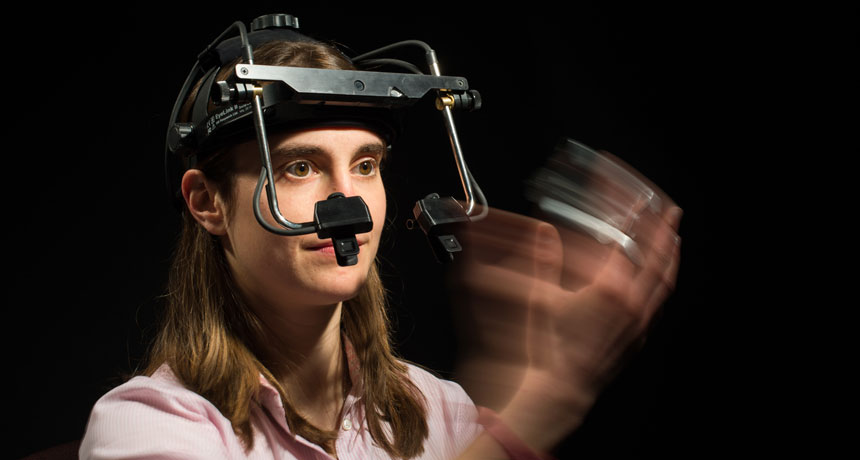Seeing without light
The brain can ‘see’ some things — even in complete darkness

This computerized device tracks the eye motion of a person wearing it. Scientists used this device to record eye movements in people who claimed they could see their own hands moving, even in total darkness.
J. ADAM FENSTER/UNIV. OF ROCHESTER
Spelunkers who explore caves often say they can see their hands move in the dark. A new study suggests those cavers aren’t hallucinating. It finds evidence that the brain sometimes creates visual “images” without input from the eyes.
The study based its conclusion on an experiment anyone can try. Find a dark place or put on a blindfold. (Or visit the nearest, darkest cave.) Next, wave your hands in front of your face. Did you see them?
Many people can, researchers report in a study published Oct. 30 in Psychological Science. Moving a hand triggers cell activity in areas of the brain involved in controlling hand motions. The brain may translate that activity into sight, even in total darkness, the new study concludes. It doesn’t matter that someone’s eyes didn’t actually detect the moving hands. The brain seems to compensate for the lack of light and “sees” the hands because it knows so well what such a common body movement would look like.
By sensing the action, the brain “‘knows’ where a moving hand is and, as our results show, it actually generates the expected visual image,” Duje Tadin reported to Science News. One of the study’s authors, this psychologist works at the University of Rochester in New York.
Tadin’s team tested 129 volunteers. All wore blindfolds that completely blocked out any light. During one trial, a researcher suggested to the volunteers that some light might get through their blindfolds. (It didn’t). Before another trial, the scientists warned the volunteers that they wouldn’t be able to see anything.
It didn’t matter what the volunteers had been told: About half claimed to see motion through the blindfold. Two reported seeing the outlines of their moving hands. A few said they could even see motion when a scientist waved his hand.
The motion-vision connection was particularly strong for nine people. All reported they regularly experience synesthesia. This is when two or more senses blend together. (Among these nine, they all reported seeing numbers and letters associated with certain colors.)
About half of the blindfolded people, however, saw nothing. Their brains may not have the same strong links between systems responsible for vision and motion, the scientists conclude.
Normally, when someone watches a moving object, her eyes will move smoothly to follow the action. So in the new trials, the scientists used computerized devices to monitor a volunteer’s eyes behind the blindfold. And the people who claimed they saw hand movements in total darkness showed such smooth eye movements.
Those eye movements suggest the brain fooled the eyes into believing they were following the motion that the brain said they ought to be seeing. If volunteers had only imagined their own hand movements, their eyes would not have responded this way, the study authors say.
Not all scientists agree. David Brang is a psychologist at Northwestern University in Evanston, Ill. He offers another explanation. Some research suggests peoples’ eyes may move smoothly even when they imagine seeing movement, he told Science News. If true, then the ability to “see” without light may depend on someone’s ability to clearly visualize images, not on the strength of any connection between vision- and motion-sensitive parts of the brain.
Power Words
neuroscience Science that deals with the structure or function of the brain and other parts of the nervous system. Researchers who work in this field are called neuroscientists.
psychology The study of the human mind, especially in relation to actions and behavior.
synesthesia A brain condition in which a person connects a sensory experience to an unassociated symbol, such as a letter or number.







